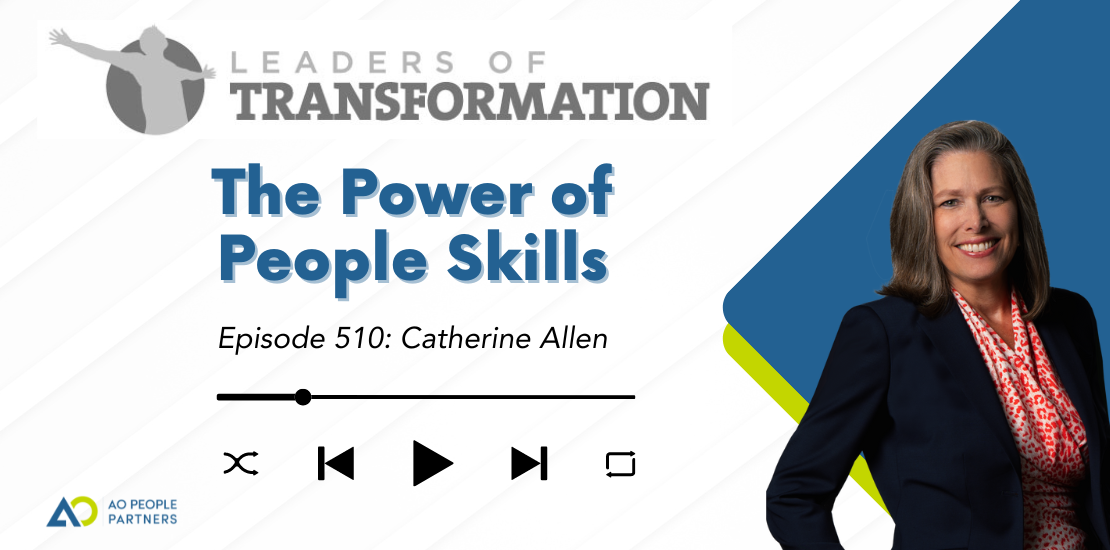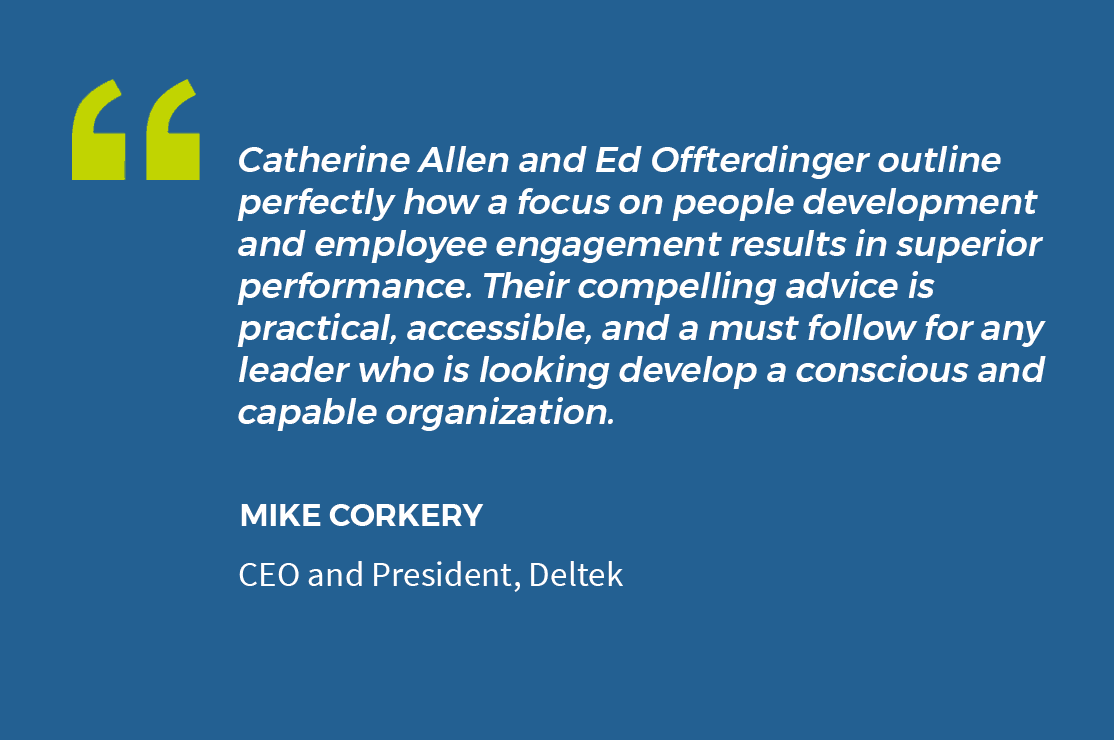- September 26, 2024
- Posted by: Caitlin Holland
- Categories: Leadership, People Development

In leadership, the art of transformation is not merely a skill but a profound responsibility that shapes the future of organizations and the communities they serve. As Co-Founder and Chief Impact Officer of AO People Partners, Catherine Allen‘s recent appearance on the “Leaders of Transformation” podcast was a revolutionary conversation that explored the impact of leadership development on both organizational success and societal contribution.
Catherine’s insights, drawn from her extensive experience and co-authorship of “Conscious, Capable, and Ready to Contribute,” provide practical strategies for fostering a culture of continuous growth and development. Take a deeper dive into these transformative ideas and prepare to be inspired.
Nicole Jansen: What if your greatest social contribution was within your company? Our guest today is Catherine Allen, co-author of “Conscious, Capable, and Ready to Contribute” and co-founder of AO People Partners, a firm focused on leadership development and workplace culture transformation. Today, we’ll break down leadership development into effective, scalable, and sustainable practices that support business strategies and contribute to society. Welcome, Catherine!
Catherine Allen: Thank you, Nicole. I’m excited to be here and discuss how leaders drive transformation in organizations and the world. It’s an exciting topic.
Nicole Jansen: Absolutely. People skills and valuing others should be obvious topics, yet they aren’t always prioritized. There’s a shift needed from old-school leadership styles.
Catherine Allen: My co-author, Ed Offterdinger, and I wrote this book for leaders, especially senior leaders. We highlight the critical role of people development in business success and societal contribution. The book is a business fable about a company turning around by embracing these ideas, and it offers practical ways to create a development-centric culture.
Nicole Jansen: Workplace transformation is a huge opportunity. Everyone is affected by the marketplace, from employees to those seeking work. We can be a light in the world through our business impact, as your book suggests.
Catherine Allen: We spend most waking hours at work, where both our best and worst qualities emerge. Organizations can transform by offering opportunities for personal growth, which employees bring home. Yet, many adults only encounter development concepts at work.
Nicole Jansen: Exactly. While workplaces aren’t therapy sessions, they’re arenas for real-time learning and growth. Leadership development focuses on essential soft skills, and investing in these areas is a business imperative.
Catherine Allen: Leadership development transforms individuals, impacting both their professional and personal lives. Companies investing in coaching and training see significant benefits, like improved communication at home.
Nicole Jansen: Yes, I’ve seen that too. Access to leadership development is limited, but it’s crucial for talent development. Developing people is more recognized today than decades ago. Companies need to focus on both technical and interpersonal skills early on.
Catherine Allen: Organizations face the challenge of integrating ongoing learning into daily work, ensuring it’s safe and relevant. The workplace should foster continuous growth and development.
Nicole Jansen: We should teach these skills early, but currently, the workplace is where they’re most relevant. Leaders might worry about time and resources, but companies that apply these principles see higher profitability and engagement. How can businesses manage these responsibilities amidst rapid change?
Catherine Allen: With compassion and respect, leaders must realize that their people are often the most expensive investment. This investment can either sink or propel a business. How you attract, retain, and develop employees, and what they say about your company, is crucial.
“The biggest factor in determining whether a leadership program will be effective and truly sustainable, or ‘sticky’, boils down to one thing: the level of engagement and commitment from an organization’s most senior leaders.” – Catherine Allen
There are two key aspects for effective and sustainable people development: it must be anchored in both the business strategy and the culture. People engage with what’s relevant and contextual. When a business strategy emphasizes people development, it shows it’s vital for success. Embedding it in the culture means it becomes part of everyday practice.
Soft skills require constant practice. Employees need to feel safe to make mistakes and learn. My co-author, Ed Offterdinger, experienced this at Baker Tilly, where they committed to developing leaders. As a result, they became a talent magnet and a billion-dollar company.
Nicole Jansen: When leaders claim they’re too busy for development, it indicates a need to prioritize it. Full team engagement can alleviate leader burdens, fostering growth and reducing overwhelm.
Catherine Allen: Scaling a business involves scaling people’s capabilities. Leadership development’s success hinges on senior leaders’ engagement. They must own, model, and drive the development agenda, normalizing learning and growth.
Nicole Jansen: Programs shouldn’t be a checkbox activity. If leaders aren’t modeling development, why should others invest in it? I’ve seen companies fail when they start development with lower-level managers instead of executives.
Catherine Allen: Simplifying people development focuses on core skills. We break them into mind skills (cognitive skills like focus and critical thinking) and people skills (interpersonal skills like emotional intelligence and teamwork). Companies should emphasize progress in these areas.
Authenticity in development matters. Businesses should develop people not just for success, but for higher purposes. We need to incentivize companies for developing capable people, just as we do for environmental and philanthropic efforts. Let’s make this a priority.
Nicole Jansen: Absolutely. Your book, “Conscious, Capable, and Ready to Contribute,” emphasizes how employee development can be a significant social contribution. Business is a vehicle for creating value and meaningful work, impacting society and the world. Your book is practical, detailing soft skills and how to develop them. For listeners, consider assessing these skills in your organization. Rate your team’s development and focus on key areas. Starting with core habits can lead to a domino effect of positive change.
Catherine Allen: If businesses value thriving, capable people as much as profits, we can build a more sustainable and equitable society. Business is a powerful platform for human flourishing.
Nicole Jansen: Yes, this transformation goes deep. Great leaders build other leaders. Thank you, Catherine, for this insightful conversation.
Catherine Allen: Thank you. This conversation has been energizing.
Nicole Jansen: Yes, we’re ready to take on the world! Leaders of transformation, take action. Whether you’re in a leadership role or aspiring to be, apply these principles. Develop soft skills to enhance your value. We’d love to hear your stories. Thank you for joining us.
For more insights on leadership development and culture transformation, email us or connect with us on LinkedIn.

